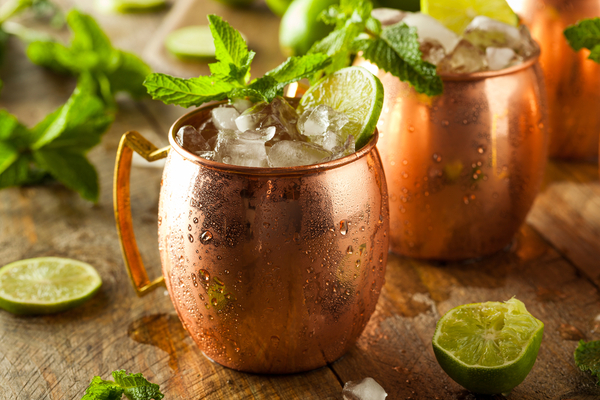Today, March 3rd, marks the fifth anniversary of Moscow Mule Day! When pondering (and pining for) this refreshing cocktail that consists of vodka, ginger beer, and lime juice, garnished by a lime wedge and mint leaves, it just doesn’t seem complete unless it’s served up in a frosty copper mug. But why?
Experts say that Moscow Mules are served in a copper mug as a result of the drink’s history, along with the physical properties of the mug. Below are the three main reasons why Moscow Mules are served in a copper mug.
1. History
Though it has a conflicting origin story, the Moscow mule was at least in part created around 1941 by Jack Morgan, the owner of the Los Angeles-based British pub Cock ‘n’ Bull. (A recent publication also says that the bartender of Cock ‘n’ Bull helped develop the drink.) According to cocktail historian Ted Haigh, Jack Morgan had a girlfriend who owned a copper-making company. Some versions suggest the original copper purveyor may have been Sophie Berezinski, a Russian immigrant. Either way, copper mugs arose as a feasible receptacle with which to brand the drink.
Together with Jack Morgan, John Martin (who had recently bought the vodka brand Smirnoff), developed the drink because neither could sell their respective goods: Morgan, ginger beer, and Martin, vodka. To market the drink, John Martin went from bar to bar, taking photos of celebrities with Moscow mules and bartenders holding copper mugs and Smirnoff vodka. This campaign boosted the popularity of the drink as served in a copper mug.
2. Temperature
Copper is a superior thermal conductor, so copper mugs respond to the temperature of what is inside, keeping it chilled or warm depending on the beverage. When containing a Moscow mule, copper mugs become cool, creating a chilling sensation when sipped. This is especially desirable in warm weather when cold drinks can easily melt.
The temperature property is particularly true for pure, unlined copper mugs. Lined copper mugs are typically copper-plated over or lined with nickel, stainless steel, or tin. Though this makes lined mugs more durable and less susceptible to copper leaching, they do not respond to temperature as precisely as unlined mugs do.
3. Taste
Cold copper seems to intensify the fizziness of the carbonation in Moscow mules, making for refreshing sips and an aromatic fragrance. Many Moscow-mule drinkers also say that the copper cup enhances the flavors of the spicy ginger beer and citrus lime.
Moscow mules were originally served in copper mugs as a response to the drink’s proximity to the product (copper mugs). However, the copper mug has proven to be a viable choice to serve this crowd-favorite, flavorful cocktail. To keep your copper cups in prime condition, always be sure to wash them properly after use.
—
Photo Credit: Brent Hofacker / Shutterstock.com
